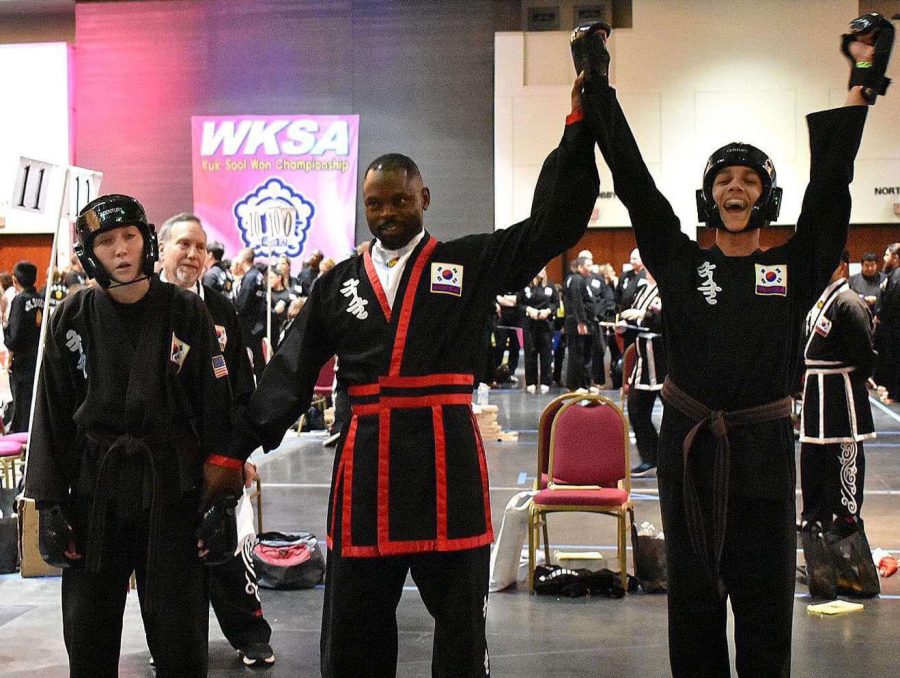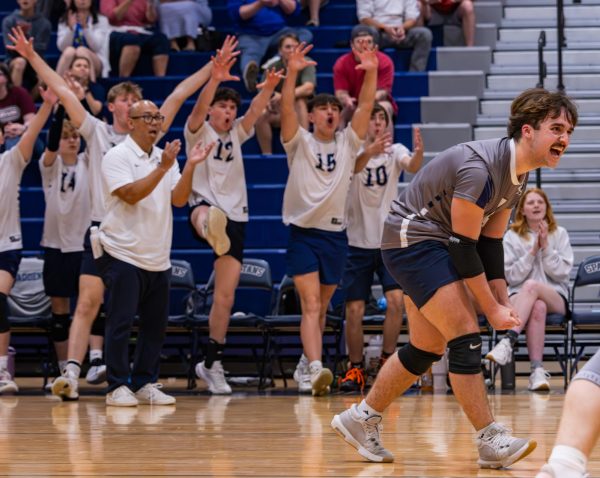Martial Arts Madness
The hectic schedule of martial arts leads to immense skill
Photo courtesy of Jacob Simpkins
Simpkins competed in the WKSA Kk Sool Won Championship in Galveston, Texas. An official raises Simpkins’ arm, signaling his triumph over the opponent.
A bead of sweat rolls down freshman Sophia Miller’s temple. Her breathing is sporadic and heavy. She and her opponent have passed the upper hand back and forth for nearly six grueling minutes. Before she knows it, her opponent knocks her onto her back, trapping her in a straight arm lock. As her arm is bent towards the mat, her face contorts into a grimace. The pain is excruciating. She’s ready to give up.
The level of physical strain required by a martial art is enough to bring most people to their breaking point. In fact, it’s moments like these that have made Miller, who has practiced jiu jitsu since sixth grade, question whether her commitment is worth the exhaustion.
“Sometimes, when you’re in a meet or something, you’re just like ‘I can’t do this anymore’,” Miller said. “But you just have to learn how to push through it.”
Kuk sool won is a traditional Korean martial art that embodies all of the traditional Korean fighting arts, including traditional weapons training, with an emphasis on techniques and acrobatics. And although it is much different than jiu jitsu, which is a Japanese artform focused on throwing, trapping and holds, kuk sool won is just as tough on the mind and body.
Jacob Simpkins, a sophomore who has practiced kuk sool won since first grade, believes that much of the difficulty in the sport relates to the dedication it requires. The time commitment in itself can make the sport feel exhausting at times.
“There’s definitely physical challenges, but there’s also a bunch of mental challenges,” Simpkins said. “Currently, I’m in a testing process for my black belt, and that takes two years. And so I’m hitting the end of that, and that burnout’s kicking in like ‘Ugh, I have to go to class.’”
Not only is the longevity of martial arts daunting, but also the hours that it requires weekly. Freshman Emma Schultheis, who started jiu jitsu a year and a half ago, attends training at the UFC Gym — the same facility as Miller — several times a week.
“I usually go up there about three times a week. And sometimes I’ll go on the weekends,” Schultheis said.
Simpkins, who has become an instructor at his school — Kuk Sool Won O’Fallon —
spends almost every day there.
“I’m an instructor at my school, so I’m there every night I can be,” Simpkins said.
It would be extremely difficult to commit at the level these athletes do, if it weren’t for the love that they have for their respective artforms. Miller has seen jiu jitsu as a fun activity that makes her stronger by the day.
“I think it’s just fun and nice to do, and it really brings people closer. And it shows that you know how to protect yourself from anything,” Miller said.
Simpkins finds that kuk sool won has provided him with a way to relieve his mind of everyday stressors, and creates a new mentality.
“My favorite thing is just the attitude that comes with it; the discipline, getting to go there every day and have fun,” Simpkins said. “It is hard work, you still get the crap beat out of you, but that’s part of the fun. It’s just somewhere you can release yourself, and let yourself be happy, and be yourself.”
In addition to being a fun activity for recreation, practicing a martial art teaches a wide span of lessons that can be applied to life outside of training.
“I’ve learned a lot of discipline. How to handle myself with people, focus on things. It’s really helped keep me stay calm throughout life,” Simpkins said.
Schultheis has found that it makes her more patient, and has improved her overall self-image.
“[It’s taught me] patience, a lot of patience. I get along with people better, because you have to be more comfortable around people… you have to have more confidence in that,” Schiltheis said. “It becomes a lot easier, and you become a lot more okay with yourself.”
And with immense dedication, comes deep attachment. After pursuing the sport for so long, Simpkins finds that the sense of familiarity it brings him is what keeps him coming back.
“When I got my black belt at my first place and had to restart, there was a lot of debating whether I should continue or not, because I had to go back to where I started, but it’s totally worth it. Stick through it, it pays off in the end,” Simpkins said. “It keeps me grounded, gives me something to look forward to. It’s always been something that I’ve had positive in my life. It’s my happy place: somewhere I can go when I’m upset.”
Something that pushes Miller to constantly redefine her limits as an athlete is self-improvement: both physical and social.
“I think it keeps me more fit, and it definitely keeps me healthier,” Miller said. “I’ve learned how to stand up for myself and how to be a better person.”
Because of these benefits, despite the hardships she faces, Miller believes that all of her hard work will pay off in the end, and that belief is what she uses to persevere through the hard times.
“What keeps me going is that I know, in the end, it’s going to benefit me, and I’ll be happy. And I’ve worked so hard for it, why quit now?” Miller explained.
She thinks back to all of the hours she’s spent training, the countless moves she’s repeated time and time again, the encouragement she receives from her friends. She’s won’t tap out so easily. Her free arm tugs at her opponent’s leg, while she swings her leg out perpendicular to her body, allowing her just enough space to roll her back off of the ground. She slides out of the hold, to the back side of her opponent, managing to place them in a guillotine choke hold. The opponent taps out. She triumphs.
Your donation will support the student journalists of Francis Howell Central High School. Your contribution will allow us to purchase equipment and cover our annual website hosting costs. FHCToday.com and our subsequent publications are dedicated to the students by the students. We hope you consider donating to allow us to continue our mission of a connected and well-informed student body.









